Discovering a Character by Drawing
This week is about illustrating characters and discovering those that feel personal.
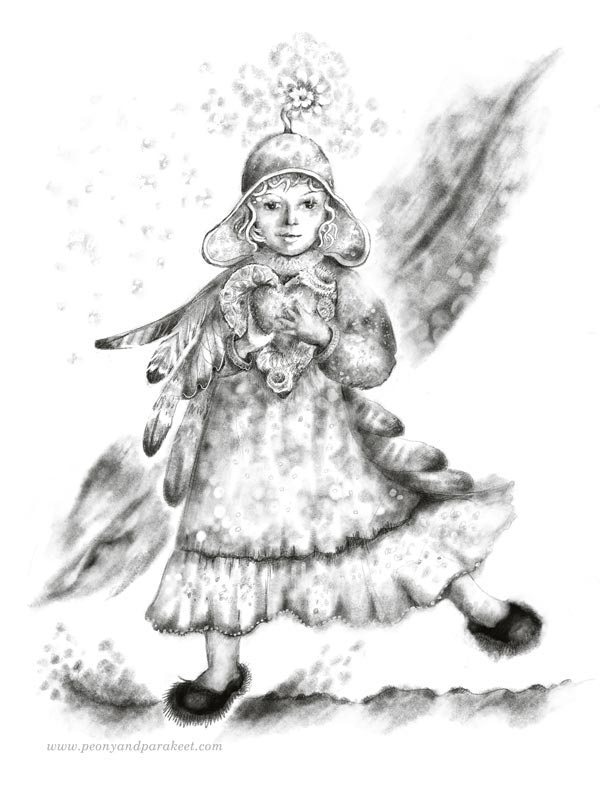
Have you ever wanted to draw a face or a figure that would really touch your heart? I don’t only mean something that looks pretty on paper but someone that begins to speak to you when your eyes meet.
Starting from an Animal Figure
In the class Magical Inkdom, I mention the word “kissanukke” when we are drawing cats. Kissanukke is “cat doll” in English, but somehow I think it’s much funnier in Finnish. Say: kissanukke! The word is just hilarious.
Last week, I wondered why I think about that word so often. Maybe it’s a hint I should draw cats again. So, I picked a big smooth watercolor paper and a pencil to sketch a huge cat. I wanted to go big because I wanted the cat’s face to be large enough for working on facial features. I adjusted them for a long time with a pencil, and then with colored pencils. I wanted this kissanukke to be more than a doll – a living thing that speaks to me.
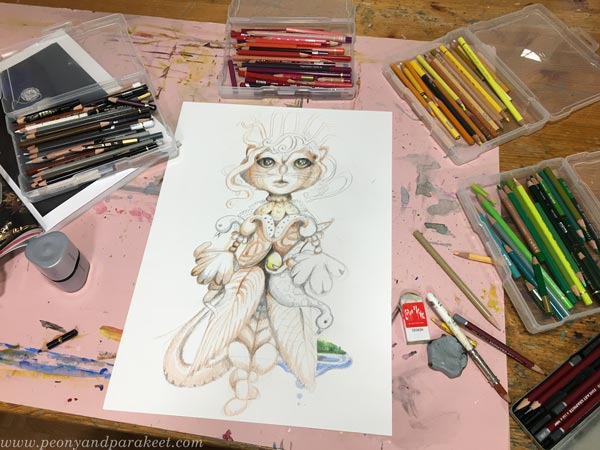
I love to use thick and smooth watercolor paper with colored pencils even when I don’t use water for the drawing.
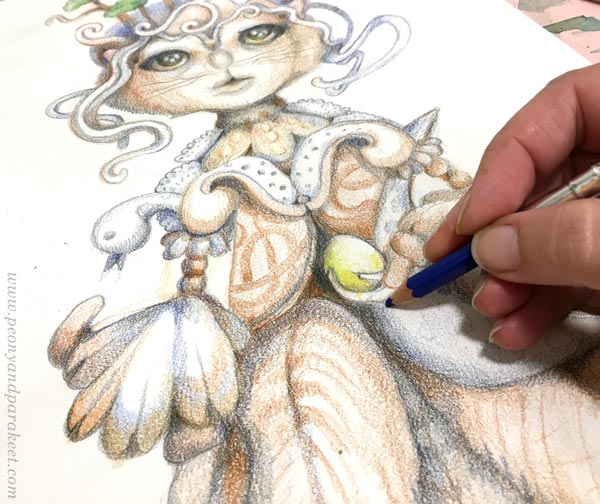
When the paper is big, it’s easy to dive deep into details and let them make the drawing more whimsical than the original sketch.
What’s Behind the Animal?
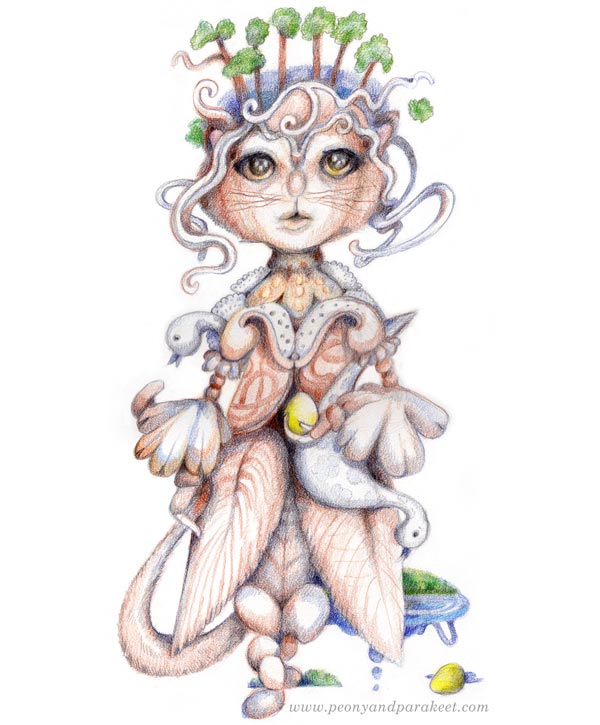
When Kissanukke was born, I asked her: “Who are you?” She said: “I am a hunter, and I can bring you anything you want!” I smiled at her: “What a magical cat you are, with the golden egg and all!” “I had two,” she said, “but the other one got missing when I tried to catch the geese. And I am no cat but a lion!”
Of course, she is a lion – how did I not see that before! I used to be a big fan of Joy Adamson and her lion Elsa as a child. No wonder my inner child has kept asking for cats!
Discovering Through a Different Pose
So, I thought, let’s draw another leijonanukke – lion doll – for the child. This time, I changed the pose so that the character would only need to glance sideways and wished that a shyer creature would appear.
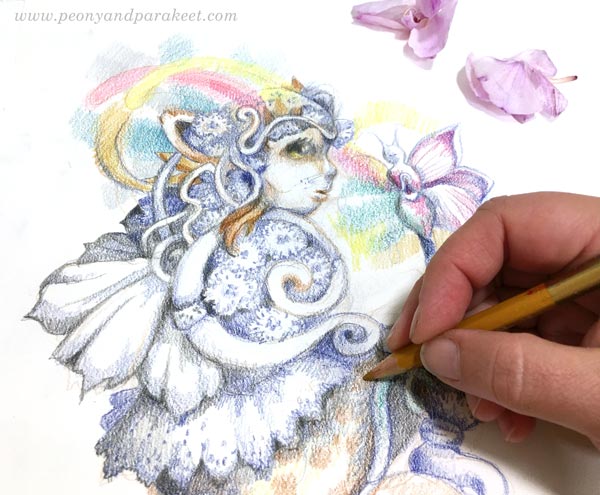
“Are you a hunter too?” I asked when discovering the new character. “No, I am an orchid whisperer! Shhh!”
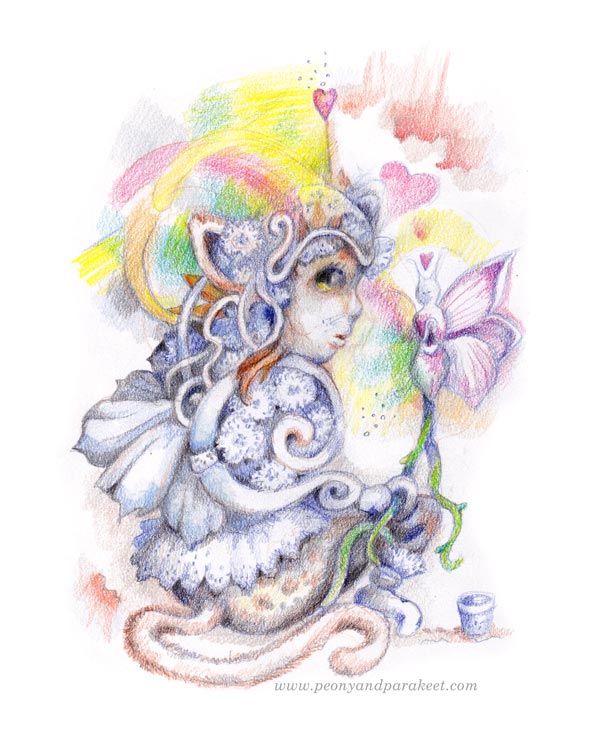
One of my orchids just stopped blooming, and I am eagerly waiting another to bloom. So, there’s a need for her too!
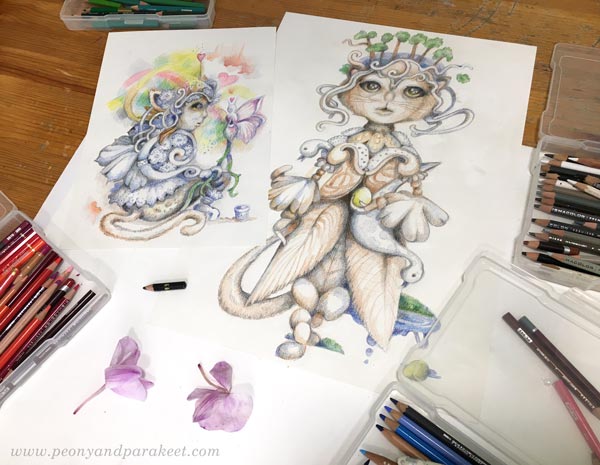
Whisperer is smaller than Hunter. The small size also makes her look less finished in the pics. If you need to provide a hand drawing in a digital form, always draw larger than the asked size. The result looks neater that way.
Discovering a Human Character
This week, I went to the studio and gathered all the courage I got. “Hunter,” I said, “could you bring me a human that really touches my heart.”
And that’s how this little country girl came out – a true nature child!
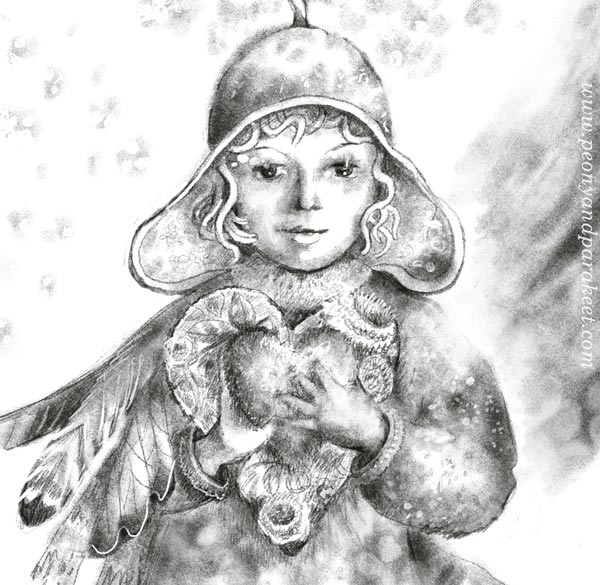
I didn’t use any references when drawing the girl and the cats. A reference can help us draw what’s expected but not what comes out naturally. References are great practice, and during the years, I have been practicing with them too. For example, in the class Innovative Portraits, we draw faces and use references creatively. But when discovering a character that feels like a soul mate, references become disturbing. Then it’s all about the connection with your inner self, traveling back in time for inspiration and forward in imagination.
Digital Pencil Work
I drew the girl on my iPad with Apple Pencil and the program called Procreate. I got these fancy tools as a birthday gift from my husband in February but have been waiting for the right moment to get to know them.
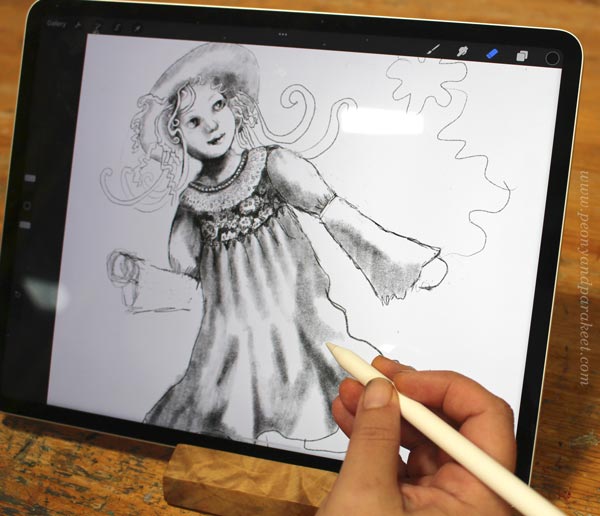
So far, I have mostly been using a simple digital brush called “Peppermint” that imitates a graphite pencil.
I will blog more about Procreate later, so it would be interesting to hear if you have used it. Also, if you have any questions, please let me know! However, if you are not into digital tools, don’t worry, I will keep on drawing with real pencils too!
Angel Drawing for the Inner Child
As a child, I had a collection of scrap reliefs – small pictures printed and cut from glossy paper. A very common one was a simple angel with a head between wings. This week, I created my version of an angel drawing.
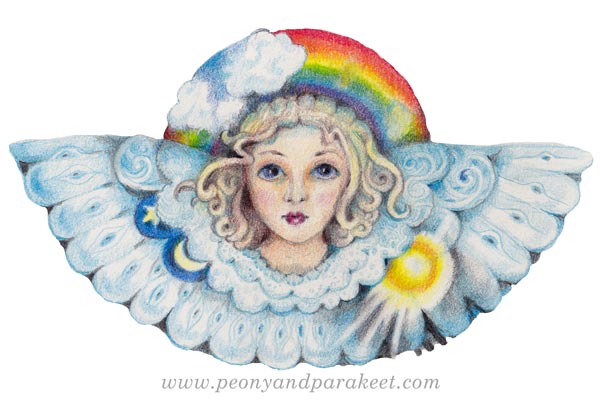
This is only a small piece on smooth watercolor paper, but the child in me likes it a lot!
My Approach to Drawing and Painting
My desire for art can be summed up in two parts. The first part is to go on an adventure by painting freely.
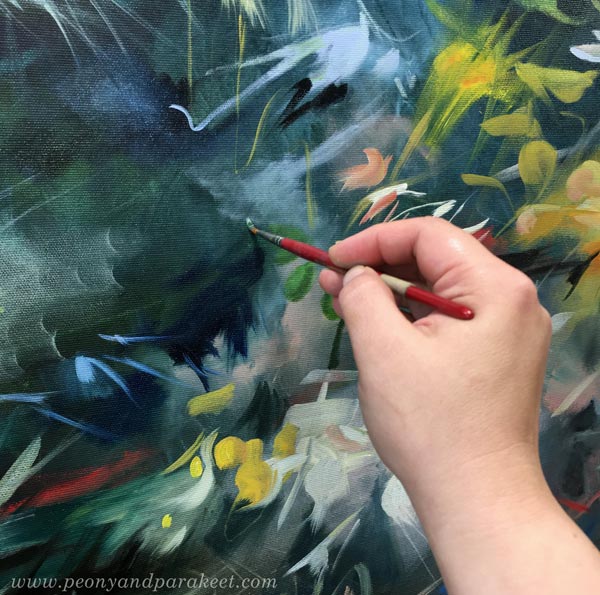
When I paint, I feel that it’s the only thing that I want to do and where I am good at.
But then, after washing the brushes, comes the second part. A child in me evokes and says: “Draw to me!” Like I often said to my father or to my sisters when I was only a few years old. The child doesn’t require much: “Something pretty!” (Watch a video about my inner child!)
Child’s Enthusiasm in Angel Drawing
I used to adore whatever my father or sisters drew. Now, similarly, I feel the acceptance of the child right from the beginning. No matter how I struggle with any detail, the child’s enthusiasm keeps me drawing.
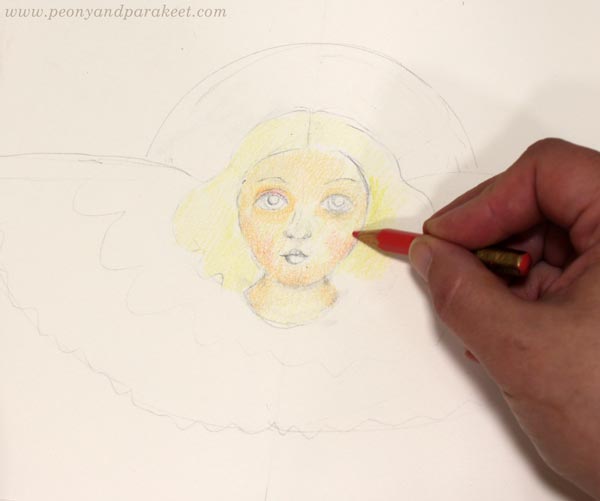
And even if I had just thought that I should only paint and do nothing else, drawing a small ornament feels as natural and enjoyable. The same creative stream seems to feed both parts of my artistic expression.
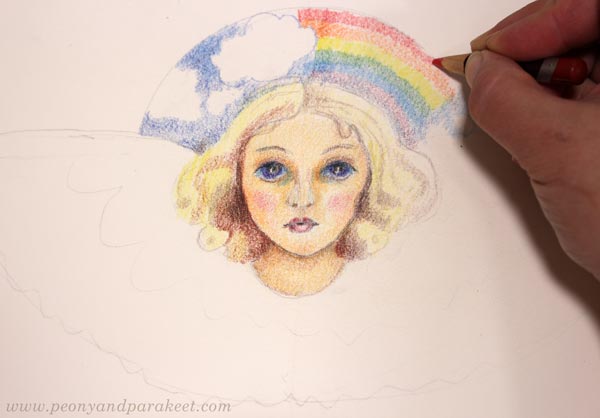
A simple sketch gets more ideas when I start adding details. Coloring a halo with yellow feels boring, so I draw clouds, then a rainbow. An unwritten story begins to flow into the image.
Small Tweaks to a Simple Sketch Make the Angel Drawing
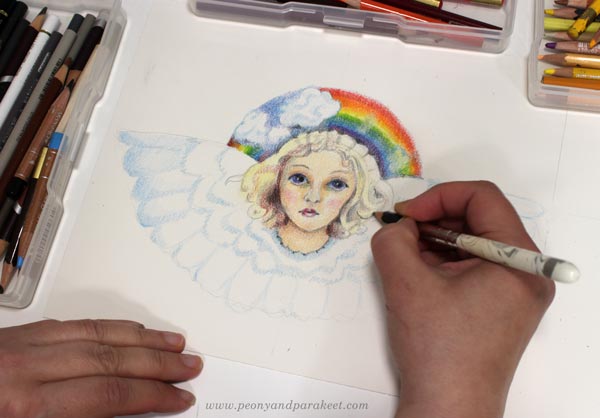
Simple shapes become more interesting when I keep drawing. Quick and simple wings get more decoration, and small adjustments to the face and hair add up.
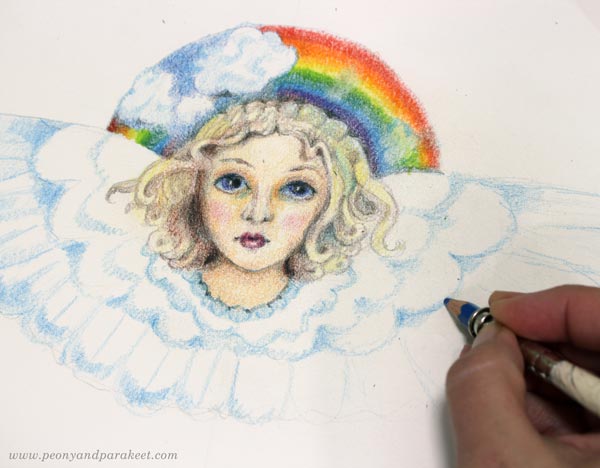
At best, I get the feeling that, like in painting, I can go in any direction and create a world of my own.
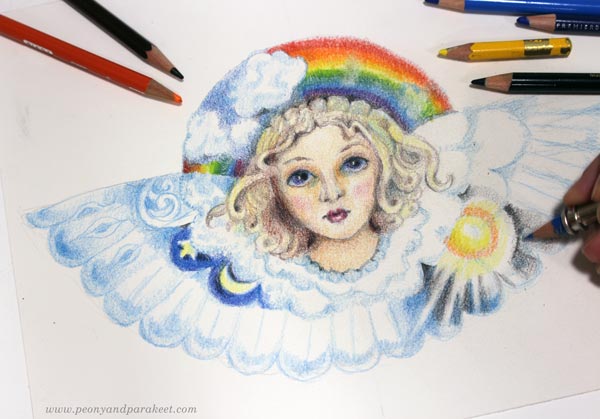
This little weather angel became a treasure to my inner child even before it was finished.
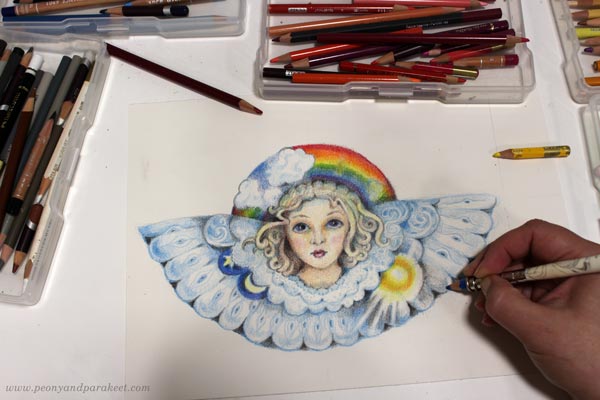
And when I handed the angel to her, she was thrilled to have her in the collection.
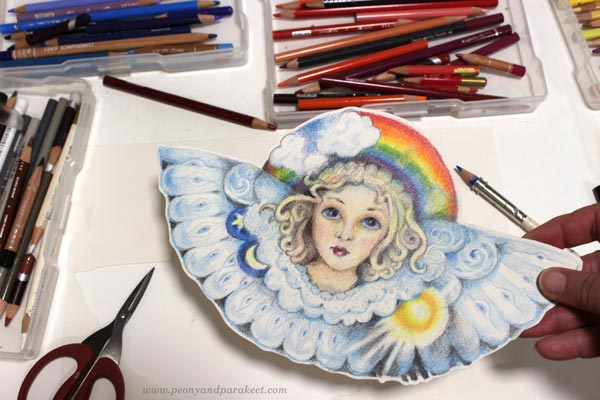
It feels that if I don’t cut the picture, it’s not ready for play!
Going Detailed with Colored Pencils
It has taken time to find colored pencil techniques to achieve similarly detailed touch like in Animal Inkdom and Magical Inkdom.
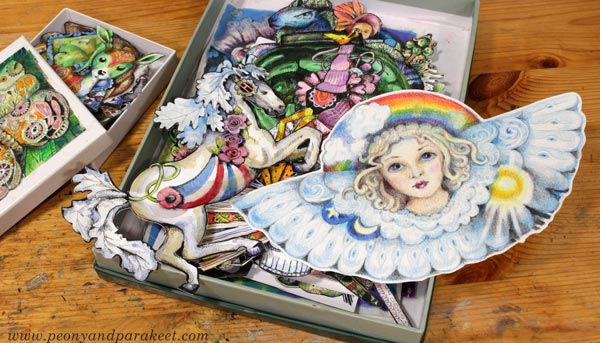
Making small pieces with colored pencils is more challenging than with ink pens, but maybe it doesn’t matter. I remember having a huge paper doll as a child. So, I could go larger without disappointing the inner child!
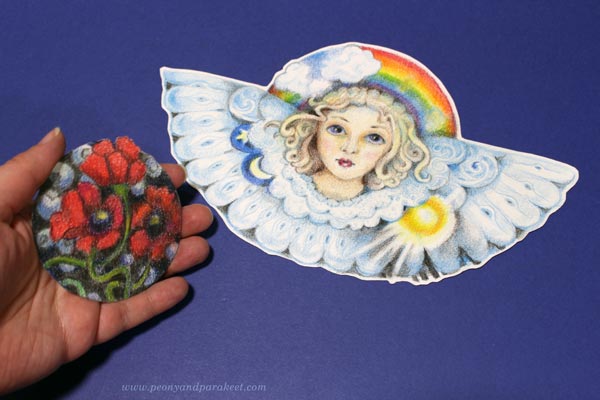
What would you like to create for your inner child?
Butterfly Art and Beyond
This week, I have some butterfly art, stories from the past, and plenty of inspiration for art-making.
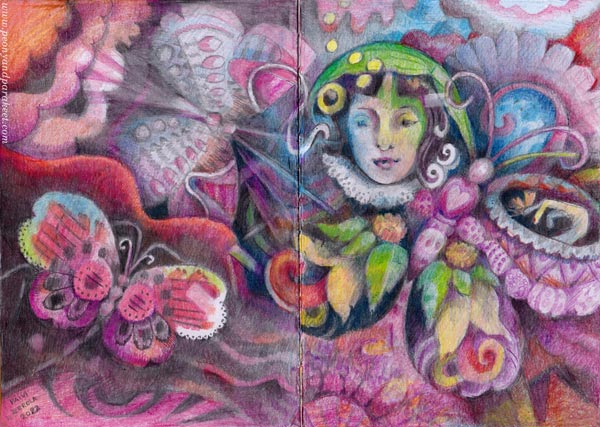
Here’s the newest spread of my colored pencil journal. I think it’s a little different than the pages so far – more detailed at least! You can see most of the previous spreads in this video; tell me what you think!
With this butterfly fantasy, I want to take you more than a hundred years back in time – to the end of the 19th century when a famous Finnish artist Helene Schjerfbeck (1862-1946) painted Violets in a Japanese Vase in 1890.
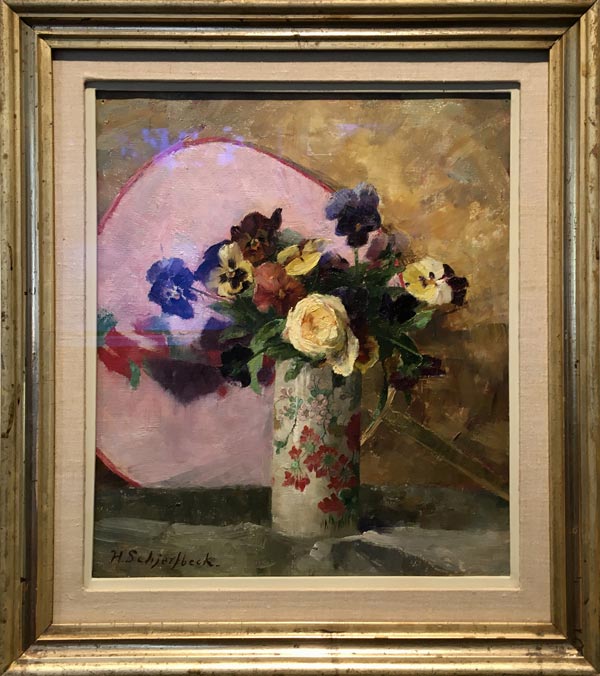
Although Helene wasn’t as famous back then, she had traveled and studied abroad. And now, she had just got back home after spending a year in Paris and England. After painting people, Helene was now drawn to make nature-themed pieces. It felt refreshing to change big and challenging portraits to small landscapes and still lives. Flowers became Helene’s consolation pieces. When she was sent to St. Petersburg to copy Russian masterpieces and thus bring educational reproductions to Finland (“here’s how the masters paint”), she painted flowers for her own joy in the evenings. (See Helene Schjerbeck’s later style and my adaptation for colored pencils in this blog post!)
I can relate to Helene. My main work is big oil paintings – abstract florals or landscapes – but I also make art that soothes and maintains rather than breaks through. While the first pieces of the new series are drying and waiting for their next layers, I feel drawn to the boxes of pencils.
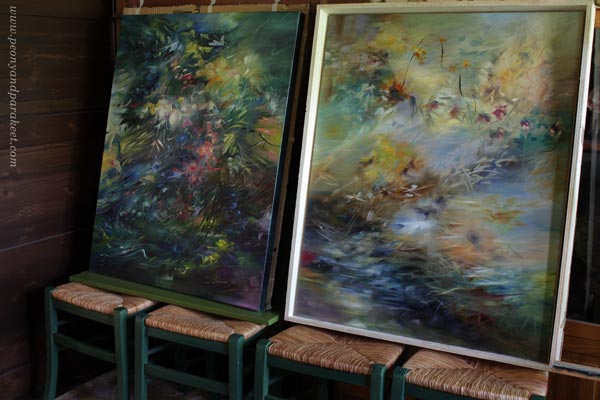
At the beginning of the week, after painting the whole Sunday, I wanted to draw something just for me. “Butterflies!” my inner child asked.
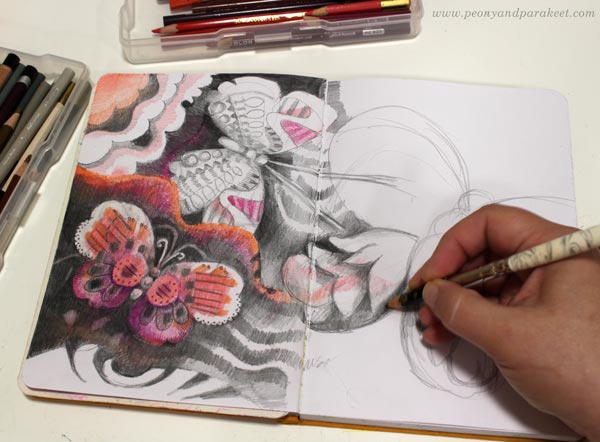
Here’s how far I got in one evening. This was before I traveled back in time to meet Helene – and another artist called Torsten Wasastjerna!
Fantasy Art in Villa Gyllenberg
In the middle of the week, my husband and I visited Villa Gyllenberg in Helsinki. It’s a museum that used to be the home of Signe and Ane Gyllenberg in the 20th century. The house was built in 1938, and it has a wonderful location near the sea.
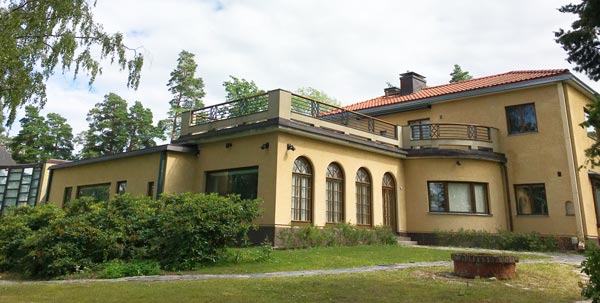
A part of the museum is a furnished old home with an extensive art collection, including Helene Schjerfbeck’s violet painting.
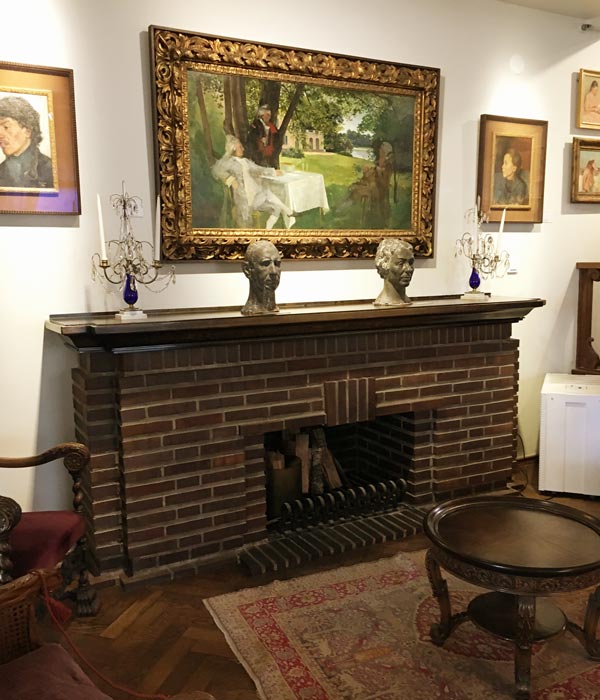
Just recently, Villa Gyllenberg got a new extension for art exhibitions. The new space has high walls and plenty of space, but still, there was something too big to fit there straight!
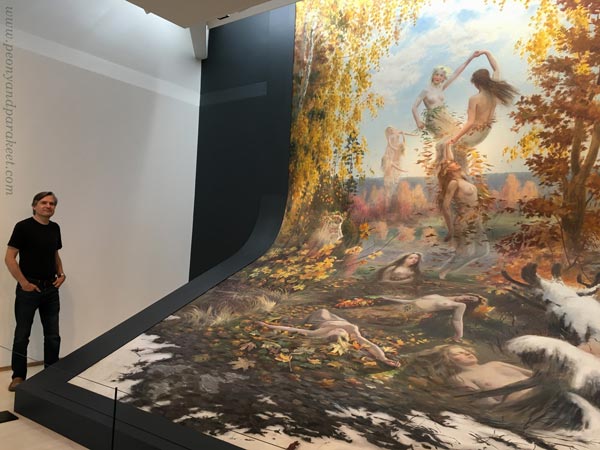
This is Torsten Wasastjerna’s oil painting Falling Leaves, made in 1897. It’s 550 cm high and 370 cm wide, one of the biggest Finnish paintings ever. My husband agreed to model beside it so that you get an idea of how big it is.
Inspired by Torsten Wasastjerna
Like Helene Schjerbeck, Torsten Wasastjerna (1863-1924) got an education in fine art and studied abroad too. But his consolation was fantasy. He did commission portraits to pay the bills but loved illustrating fairies and angels. He even wrote books. The first one was called Dröm och Värklighet – Dream and Reality.
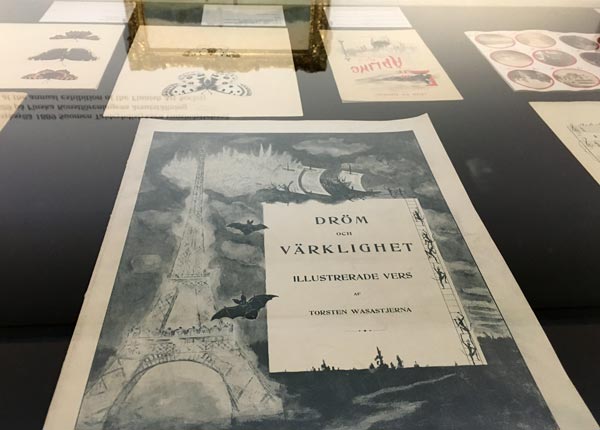
Torsten Wasastjerna’s fantasy world wasn’t as surreal as mine, but it felt close.
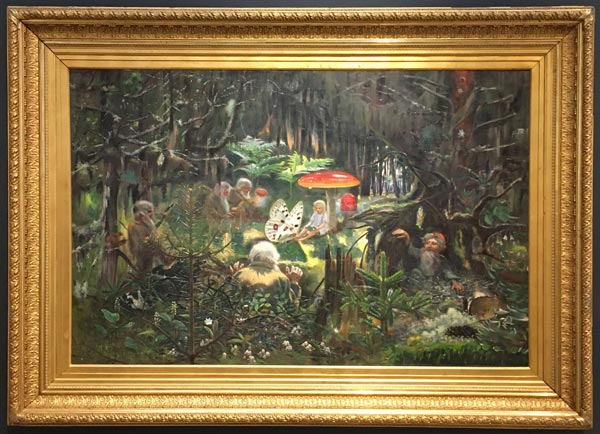
When I got back home, I was inspired to work on the butterfly piece with much more detail than I first had planned.
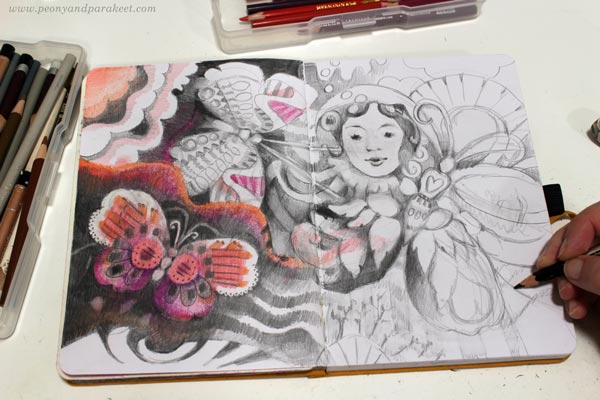
I added a person, a butterfly girl or a boy, to one of the wings.
Butterfly Art and Beyond
I am impressed by how dedicated Torsten was to his fantasy art, even if it was not valued by others.
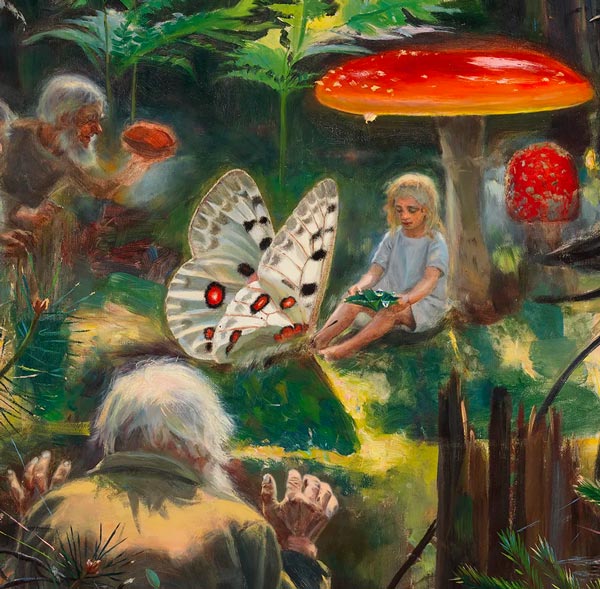
It made me think that I, too, can create “butterfly art” that goes beyond the butterflies – that challenges both my imagination and dedication.
So, I spent more hours than normally with this spread, adding details and then adjusting their shapes and colors.
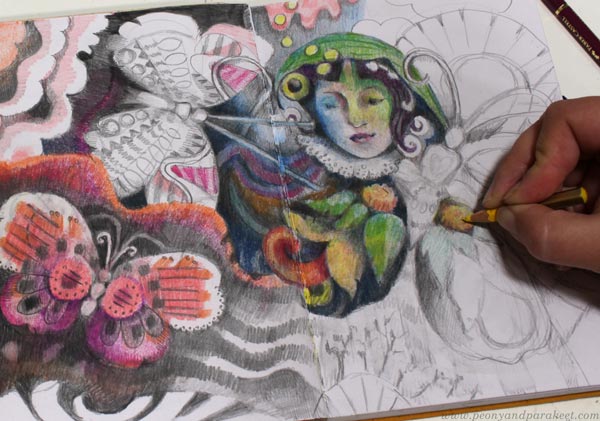
It felt like my pencils reached a new level, getting closer to my heart than before.
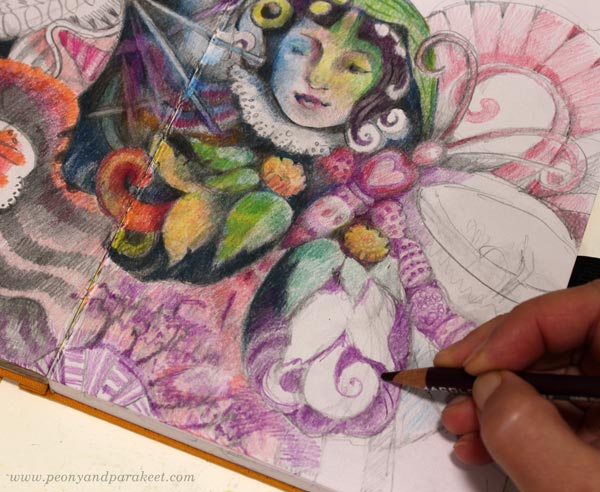
The world that is naturally and effortlessly born in my paintings fed the more illustrative work too.
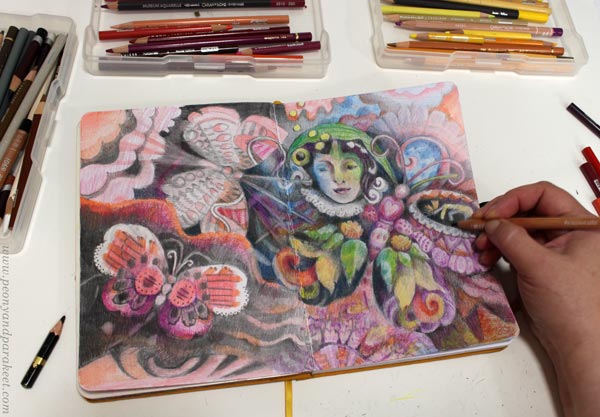
All this makes me think about how important it is to go to see art and use that for inner discussions: how am I different, what are my consolation pieces, and how do I show my dedication to art? Then butterfly art can go beyond butterflies in the same way as Helene’s violets are not just “violet art.”
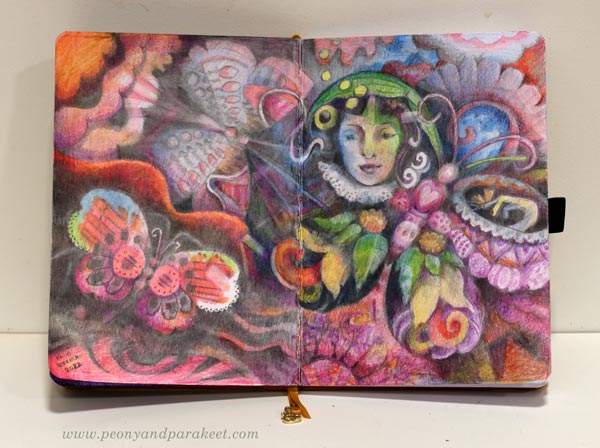
What do you think?
Creative Take on Damask Motifs
This week, we look at damask motifs from a new perspective. I challenge you to make this traditional motif your own and use it in your art!
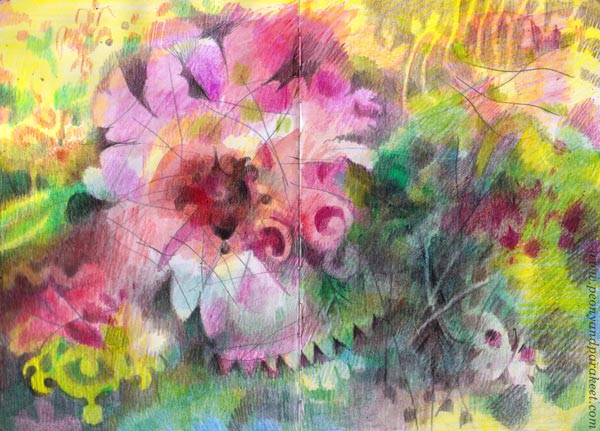
It all started from a dream I saw a few days ago. “You should wear more decorative clothes, Paivi,” I was telling myself. “Like the old historical dress that you had at a ball as a teenager.”
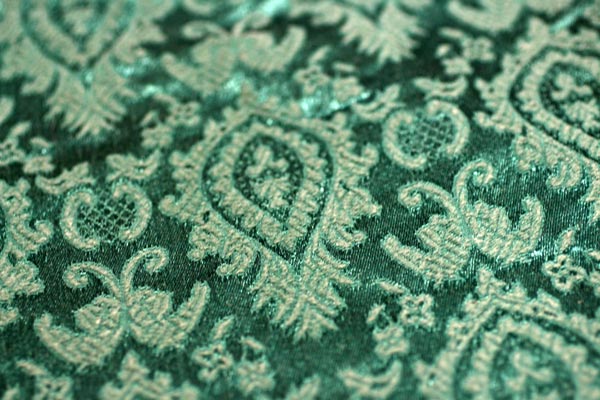
I still have the dress. It has damask motifs – woven ornamental patterns that seem to never go out of date (more about their history). The idea of perfecting not only the actual swirls but also the shapes between is a good drawing practice that doesn’t have to be boring at all!
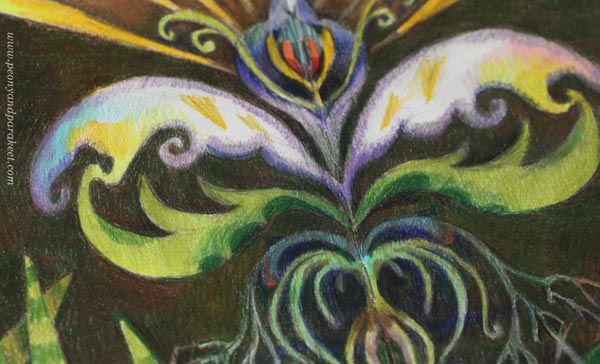
This week, I played with colored pencils mostly, but in 2015, I made a mixed media piece called Rococo. So check out this post too!
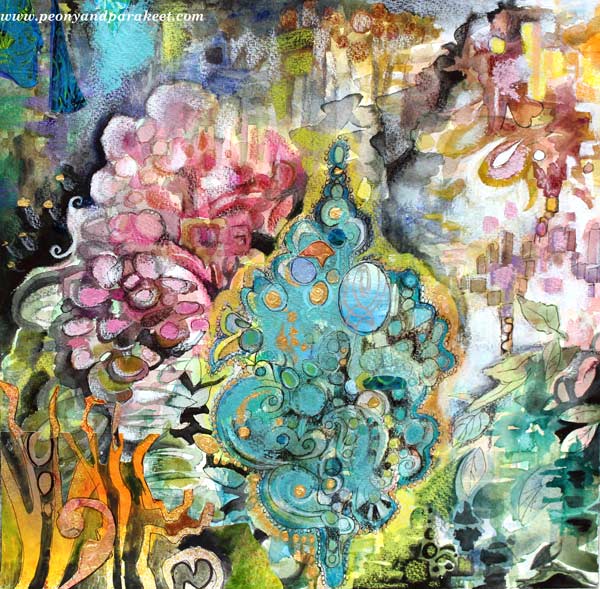
Damask Lady
The reason for my dream was an unfinished page in my colored pencil journal. I had started it at the end of last year but found it terribly uninspiring. I didn’t feel any connection with the figure, and she looked like someone had forced her to be there. In a way, that had happened. After a series of big paintings, I was knackered, as readers from the UK and Australia would describe. I had no motivation to take a brush and only a little to do something with colored pencils.
First, I added a bit of watercolor to cover white and then colored intuitively without any predefined ideas or models.
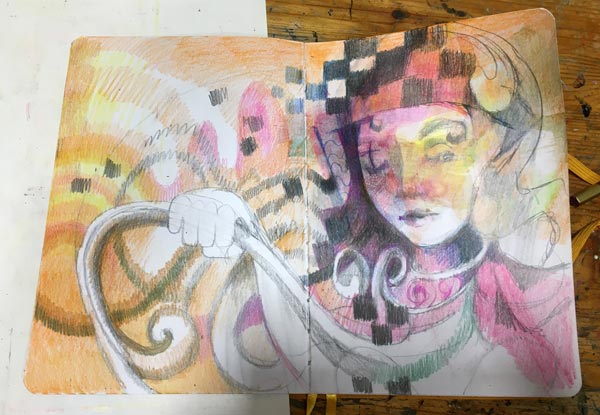
Sometimes it’s just that when you are tired, it’s best to leave the piece and come back later, even if it would be a tiny spread in a small journal. After the dream, I knew what to do: play with damask motifs!

I feel drawn to this damask lady. She looks both curious and self-confident – everything I would like to be in this new year!
Looser Damask Motifs – Nature
I got so inspired by coloring the swirly lady that the next spread was born quickly. Again, first some watercolor splashes, and then details with colored pencils.
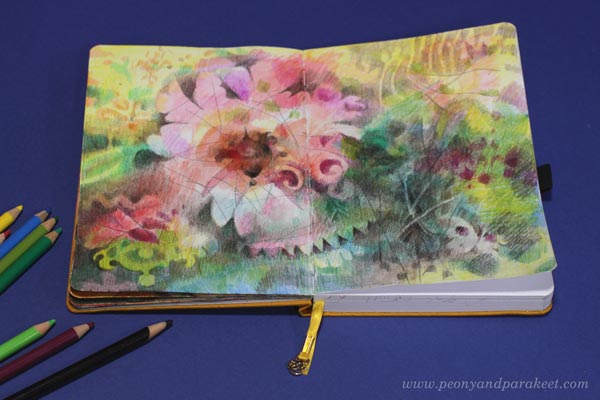
If you compare the flowery spread above with the portrait below, you see the change in looseness. The flower is much freer than the lady, but I like both. I like how damask motifs can be seen as a part of nature – snow on trees, water drops, butterfly wings and their spots. But I also like how they can be more architecture- and design-related and a part of human fantasies and mysteries.
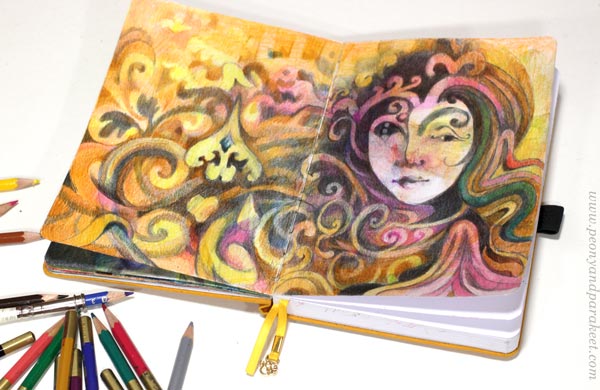
Which take do YOU like more?
Sketching a Damask Motif
Next, I wanted to go even further in stiffening the expression. I would design a damask-inspired motif so that there would be no looseness at all.
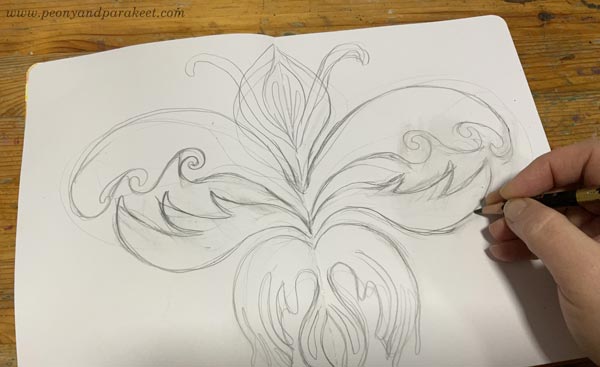
I started by sketching the motif in the middle of the spread, using the fold as a guide to achieving the required symmetry. In damask motifs, the negative – the shape of the background – is as important as the positive is. So after the careless sketch, I then went through the surrounding area and adjusted its swirls.
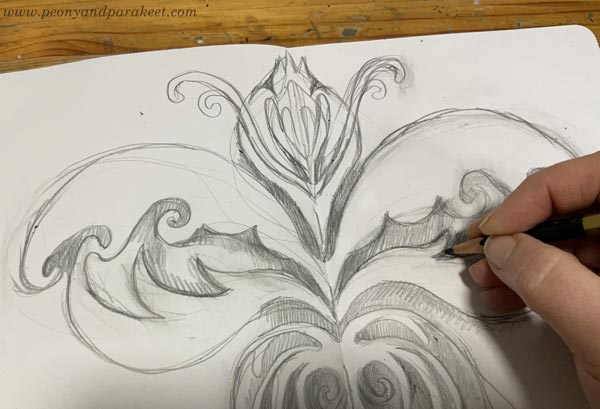
This motif felt like a forbidden fruit. I was surprised to hear myself saying: “You have crossed the line now, Paivi. Even if you always paint the inside, now it will be reverse – illustrating the outside world.” I didn’t get this first at all – I thought I was just drawing was a simple flowery ornament inspired by damask motifs!
But when I was making the finishing touches, I realized that my drawing did illustrate the outside world – our living room: a wooden ceiling, windows on the left, a wall rug on the right, a vanda orchid hanging without a pot, and the snake plants growing lower.
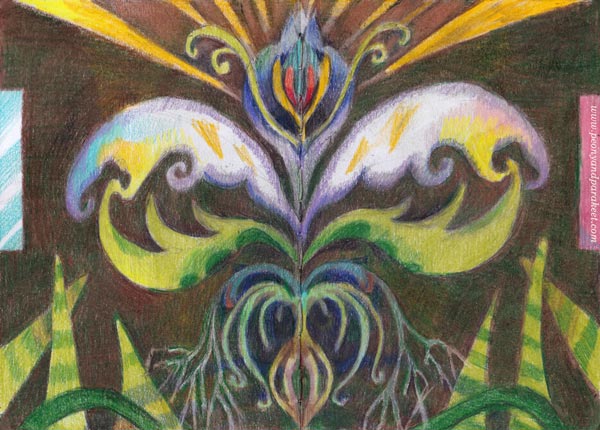
Here’s a picture of my vanda when it was blooming in 2020!
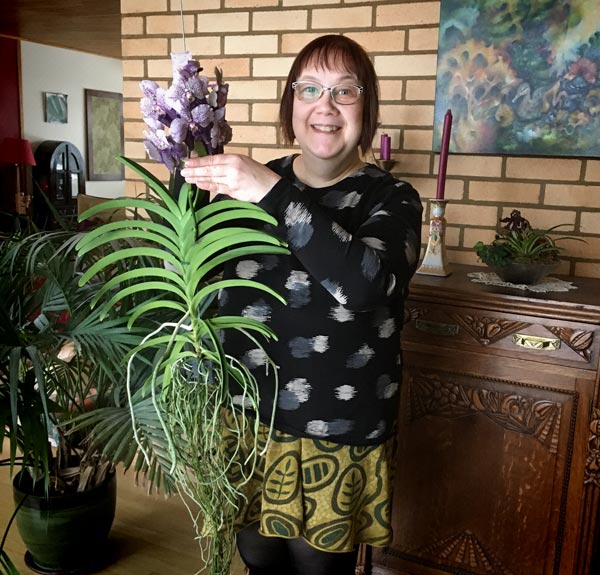
This spread is not loosely made at all, and yet I find that the looseness is how I unconsciously picked and interpreted the subject.
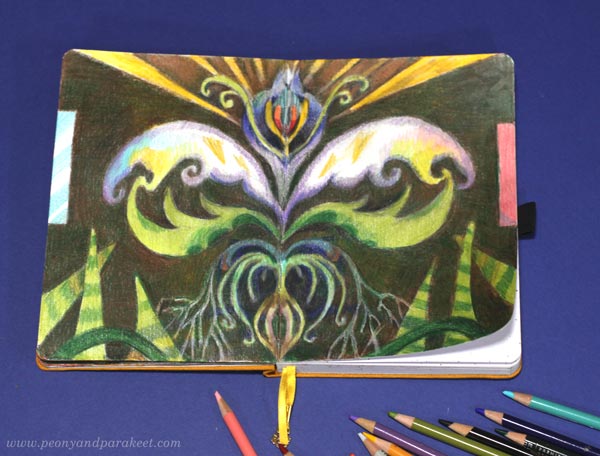
Which of the pieces of this post inspire you the most?
Are you inspired by the stiffness or looseness?
How do you want your damasks to look?
Please leave a comment! It would be so interesting to know!